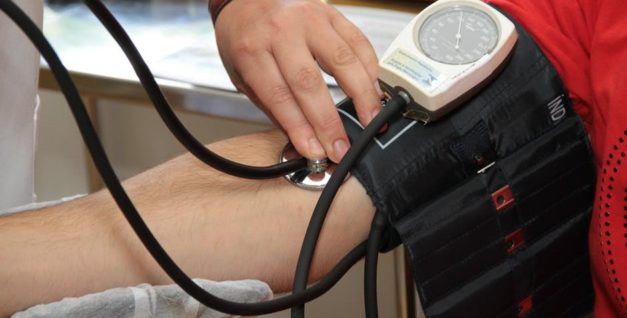High blood pressure, medically known as ‘hypertension’, is grouped into five main categories and depending on the category you fall into your approach to high blood pressure, including the treatment options will vary.
Before delving into the different stages of hypertension, let us first understand how blood pressure is measured.
Measuring blood pressure
The blood pressure meter or monitor, medically known as ‘Sphygmomanometer’, is the instrument used for measuring blood pressure.
An inflatable cuff is placed around your arm, and a reading is taken from the gauge in mmHg (millimeters of mercury).
There are two numbers (upper and lower numbers) that are mentioned whenever a reading for blood pressure is taken. The numbers are called the ‘systolic’ and the ‘diastolic’ blood pressure readings. The former is the pressure in your blood vessels when the heart beats and the latter is when the heart rests between beats.
So, when doctors say 120 over 80 (120/80), it means your systolic pressure is 120 mmHg, and diastolic is 80 mmHg.
How is high blood pressure diagnosed?
When you go for a blood pressure check, your doctor will generally take more than two readings at different times (or visits) to ensure that the diagnosis is correct. In fact, the blood pressure may also be taken at different settings, to avoid possible inclusion of white coat hypertension.
Do you remember all the types of hypertension? Follow the link if you missed that article somehow.
There is also an ambulatory blood pressure test where the blood pressure is monitored for 24 hours to gauge whether you have high blood pressure. The doctor will also review your medical history, and conduct a broad examination before confirming whether you have high blood pressure. There are some routine checks done like urinalysis, cholesterol test, electrocardiogram (ECG) and so on.
After the many tests, a doctor concludes if a patient has high blood pressure or not and the severity of the blood pressure. 
Now let us take a look at the different severity stages of hypertension and how the readings fall in each of these categories.
Normal blood pressure
The name indicates what this stage refers to. Yes, it is when your blood pressure is well within the normal range, with the normal range being less than 120 mmHg at the highest ‘systolic’ reading and less than 80 mmHg at the lowest ‘diastolic’ reading.
Elevated blood pressure
When the upper ‘systolic’ number is greater than 120 mmHg and less than 129 mmHg, with the diastolic or the lower number continuing under 80 mmHg, then it is classified as elevated hypertension. Causes for elevated blood pressure include any factors that can lead to an increase in blood pressure like,
- Overweight or Obesity
- Family history
- Age and lack of exercise
- Alcoholism, smoking and other drug abuse
- Deficiency in potassium
- A salty diet (intake of more sodium)
- Fat build up in the arteries called atherosclerosis
- Kidney diseases
- Thyroid problems
- Adrenal disease
- Obstructive sleep apnea
- Side effects of certain drugs and over the counter medicines.
While very common in adults, even children sometimes fall prey to elevated hypertension.
If left unattended, there are chances for the elevated blood pressure developing into more severe hypertension with serious repercussions.
Stage 1 hypertension
This is the first stage of hypertension where the upper ‘systolic’ pressure lies between 130 mmHg and 139 mmHg with the lower ‘diastolic’ pressure ranging between 80 mmHg to 89 mmHg.
The causes and risk factors for stage 1 hypertension is similar to that of elevated hypertension with age, family history, lifestyle habits and underlying sicknesses being the major influencing factors.
While stage 1 hypertension may not require immediate admission into a hospital, if other medical conditions like kidney disease accompany it, then immediate medical attention may be required.
Stage 2 hypertension
Stage 2 hypertension is classified when the upper ‘systolic’ pressure crosses the 140 mmHg mark, and the lower ‘diastolic’ pressure crosses the 90 mmHg.
From old age to genetics, from smoking to lack of exercise, the causes for the blood pressure at stage 2 remain the same as the previous two stages. Pre-existing medical conditions such as kidney diseases, adrenal disorders, hypothyroidism or hyperthyroidism, are likely to be associated with this stage of hypertension.
When the patient is in stage 2, there is a need for regular blood pressure monitoring and medical attention to prevent progression to hypertensive crisis.

Hypertensive Crisis – This is a medical emergency!
If the systolic pressure reaches above 180 mmHg and or the diastolic reaches beyond 120 mmHg, then the patient is said to suffer from hypertensive crisis. This is a stage where the patient needs immediate medical attention as now there are possibilities of organ damage.
While different factors like age and genetics may initiate early stages of hypertension, the crisis level is caused owing to one or many of the following reasons.
- Not taking the medication for blood pressure
- Heart attack, heart failure or stroke.
- Kidney failure
- Rupture in the aorta, the main artery of our body
- ‘Eclampsia‘ during pregnancy
- Drug interactions that cause a sudden spike in blood pressure
These patients are likely to have diseases like renal disease or heart disease in medical history. If the emergency was not managed well and timely, it could result in life-threatening complications including organ damage or death.
The treatment for blood pressure and the medications will vary based on the cause of the blood pressure and the stage of hypertension.
Of course, the best way to counter hypertension is to make changes in your lifestyle, instilling healthy diet and exercise routine. There is never a good time than now to include a balanced diet, starting on a workout program or to quit alcohol and smoking. These changes will not just battle out hypertension, but it will also keep you healthy and fit in general.










This is a great article about hypertension nice content, good read and informative. Learn a lot of stuff today.
Great Content and Information!
What a concise and thorough article. I found the post very detailed and Informative. So so many useful tips and tricks all on one page! Wonderful! I bookmarked to look further. I am just getting to know we have different types and stages of hypertension. This is an eye opener for me and I can attest to the fact that I learnt a bunch from this insightful article.
Hi there,
Thanks for your kind words. We are pleased that you found the article useful.
Best wishes.